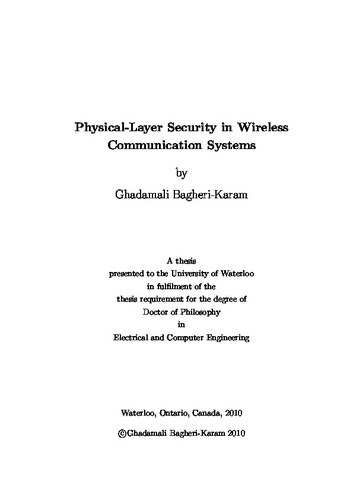| dc.description.abstract | The use of wireless networks has grown significantly in contemporary
times, and continues to develop further. The broadcast nature of
wireless communications, however, makes them particularly vulnerable
to eavesdropping. Unlike traditional solutions, which usually handle
security at the application layer, the primary concern of this
dissertation is to analyze and develop solutions based on coding
techniques at the physical-layer.
First, in chapter $2$, we consider a scenario where a source node
wishes to broadcast two confidential messages to two receivers,
while a wire-tapper also receives the transmitted signal. This model
is motivated by wireless communications, where individual secure
messages are broadcast over open media and can be received by any
illegitimate receiver. The secrecy level is measured by the
equivocation rate at the eavesdropper. We first study the general
(non-degraded) broadcast channel with an eavesdropper, and present
an inner bound on the secrecy capacity region for this model. This
inner bound is based on a combination of random binning, and the
Gelfand-Pinsker binning. We further study the situation in which the
channels are degraded. For the degraded broadcast channel with an
eavesdropper, we present the secrecy capacity region. Our achievable
coding scheme is based on Cover's superposition scheme and random
binning. We refer to this scheme as the Secret Superposition Scheme.
Our converse proof is based on a combination of the converse proof
of the conventional degraded broadcast channel and Csiszar Lemma. We
then assume that the channels are Additive White Gaussian Noise and
show that the Secret Superposition Scheme with Gaussian codebook is
optimal. The converse proof is based on Costa's entropy power
inequality. Finally, we use a broadcast strategy for the slowly
fading wire-tap channel when only the eavesdropper's channel is
fixed and known at the transmitter. We derive the optimum power
allocation for the coding layers, which maximizes the total average
rate.
Second, in chapter $3$ , we consider the
Multiple-Input-Multiple-Output (MIMO) scenario of a broadcast
channel where a wiretapper also receives the transmitted signal via
another MIMO channel. First, we assume that the channels are
degraded and the wiretapper has the worst channel. We establish the
capacity region of this scenario. Our achievability scheme is the
Secret Superposition Coding. For the outerbound, we use notion of
the enhanced channels to show that the secret superposition of
Gaussian codes is optimal. We show that we only need to enhance the
channels of the legitimate receivers, and the channel of the
eavesdropper remains unchanged. We then extend the result of the
degraded case to a non-degraded case. We show that the secret
superposition of Gaussian codes, along with successive decoding,
cannot work when the channels are not degraded. We develop a Secret
Dirty Paper Coding scheme and show that it is optimal for this
channel. We then present a corollary generalizing the capacity
region of the two receivers case to the case of multiple receivers.
Finally, we investigate a scenario which frequently occurs in the
practice of wireless networks. In this scenario, the transmitter and
the eavesdropper have multiple antennae, while both intended
receivers have a single antenna (representing resource limited
mobile units). We characterize the secrecy capacity region in terms
of generalized eigenvalues of the receivers' channels and the
eavesdropper's channel. We refer to this configuration as the MISOME
case. We then present a corollary generalizing the results of the
two receivers case to multiple receivers. In the high SNR regime, we
show that the capacity region is a convex closure of rectangular
regions.
Finally, in chapter $4$, we consider a $K$-user secure Gaussian
Multiple-Access-Channel with an external eavesdropper. We establish
an achievable rate region for the secure discrete memoryless MAC.
Thereafter, we prove the secrecy sum capacity of the degraded
Gaussian MIMO MAC using Gaussian codebooks. For the non-degraded
Gaussian MIMO MAC, we propose an algorithm inspired by the
interference alignment technique to achieve the largest possible
total Secure-Degrees-of-Freedom . When all the terminals are
equipped with a single antenna, Gaussian codebooks have shown to be
inefficient in providing a positive S-DoF. Instead, we propose a
novel secure coding scheme to achieve a positive S-DoF in the single
antenna MAC. This scheme converts the single-antenna system into a
multiple-dimension system with fractional dimensions. The
achievability scheme is based on the alignment of signals into a
small sub-space at the eavesdropper, and the simultaneous separation
of the signals at the intended receiver. We use tools from the field
of Diophantine Approximation in number theory to analyze the
probability of error in the coding scheme. We prove that the total
S-DoF of $\frac{K-1}{K}$ can be achieved for almost all channel
gains. For the other channel gains, we propose a multi-layer coding
scheme to achieve a positive S-DoF. As a function of channel gains,
therefore, the achievable S-DoF is discontinued. | en |

